JavaScript is disabled for your browser. Some features of this site may not work without it.
| dc.contributor.author | Ali, Naser | |
| dc.contributor.author | Bahman, Ammar M. | |
| dc.contributor.author | Aljuwayhel, Nawaf F. | |
| dc.contributor.author | Ebrahim, Shikha A. | |
| dc.contributor.author | Mukherjee, Sayantan | |
| dc.contributor.author | Alsayegh, Ali | |
| dc.date.accessioned | 2021-11-11T15:22:02Z | |
| dc.date.available | 2021-11-11T15:22:02Z | |
| dc.date.issued | 2021-06-21 | |
| dc.identifier.citation | Ali N, Bahman AM, Aliuwayhel NF, et al., (2021) Carbon-based nanofluids and their advances towards heat transfer applications—a review. Nanomaterials, Volume 11, Issue 6, June 2021, Article number 1628 | en_UK |
| dc.identifier.uri | https://doi.org/10.3390/nano11061628 | |
| dc.identifier.uri | https://dspace.lib.cranfield.ac.uk/handle/1826/17259 | |
| dc.description.abstract | Nanofluids have opened the doors towards the enhancement of many of today’s existing thermal applications performance. This is because these advanced working fluids exhibit exceptional thermophysical properties, and thus making them excellent candidates for replacing conventional working fluids. On the other hand, nanomaterials of carbon-base were proven throughout the literature to have the highest thermal conductivity among all other types of nanoscaled materials. Therefore, when these materials are homogeneously dispersed in a base fluid, the resulting suspension will theoretically attain orders of magnitude higher effective thermal conductivity than its counterpart. Despite this fact, there are still some challenges that are associated with these types of fluids. The main obstacle is the dispersion stability of the nanomaterials, which can lead the attractive properties of the nanofluid to degrade with time, up to the point where they lose their effectiveness. For such reason, this work has been devoted towards providing a systematic review on nanofluids of carbon-base, precisely; carbon nanotubes, graphene, and nanodiamonds, and their employment in thermal systems commonly used in the energy sectors. Firstly, this work reviews the synthesis approaches of the carbon-based feedstock. Then, it explains the different nanofluids fabrication methods. The dispersion stability is also discussed in terms of measuring techniques, enhancement methods, and its effect on the suspension thermophysical properties. The study summarizes the development in the correlations used to predict the thermophysical properties of the dispersion. Furthermore, it assesses the influence of these advanced working fluids on parabolic trough solar collectors, nuclear reactor systems, and air conditioning and refrigeration systems. Lastly, the current gap in scientific knowledge is provided to set up future research directions. | en_UK |
| dc.language.iso | en | en_UK |
| dc.publisher | MDPI | en_UK |
| dc.rights | Attribution 4.0 International | * |
| dc.rights.uri | http://creativecommons.org/licenses/by/4.0/ | * |
| dc.subject | carbon nanotubes | en_UK |
| dc.subject | graphene | en_UK |
| dc.subject | nanodiamond | en_UK |
| dc.subject | parabolic trough solar collector | en_UK |
| dc.subject | nuclear reactor | en_UK |
| dc.subject | air conditioning and refrigeration | en_UK |
| dc.title | Carbon-based nanofluids and their advances towards heat transfer applications—a review | en_UK |
| dc.type | Article | en_UK |
| dc.identifier.eisbn | 2079-4991 |
Files in this item
The following license files are associated with this item:
This item appears in the following Collection(s)
-
Staff publications (SATM) [4395]

